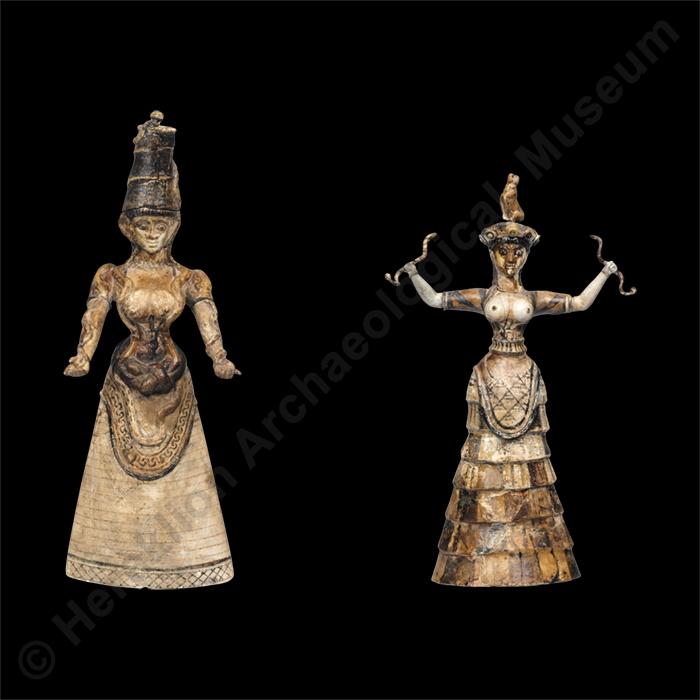"Snake Goddess" figurines
Υ63, Υ65
Faience
Υ63: Mended from very many fragments. Restored on most of the skirt and parts of the body and neck. Υ65: Restored on part of the skirt, the left arm and the head.
Height: 33.8 cm. (Υ63). 29 cm. (Υ65)
Knossos
Palace
Middle -Late Bronze Age. Neopalatial period, Middle Minoan ΙΙΙΒ - Late Minoan ΙA period.:
1650 - 1550 BC:
Gallery:
VIIICase:
83Exhibition thematic unit:
Late Bronze Age - Neopalatial period (1700-1450 BC). Minoan religion. Palace cultThe Temple Repositories of the palace of Knossos
Description
Painted faience figurines known as “Snake Goddesses”. The various parts were made separately in moulds and joined with wire. The female figures are interpreted as goddesses or priestesses. Their name is due to the snakes coiling around the body and the tall headdress of the largest figure, and the snakes held by the smaller figure. Snakes symbolise the chthonic nature of the figures, their association with the underworld, while the feline on the head of the smaller figurine signifies her dominion over wildlife. The long, flounced skirt, the woven or embroidered apron and the tight bodice leaving the breasts exposed are familiar from other Minoan depictions of goddesses and priestesses. The figurines form part of an assemblage that includes pieces of six or seven similar figurines and six models of female garments with motifs conveying religious symbolism, all made of faience. All these artefacts, together with other ritual objects, were used in the Central Palace Sanctuary of Knossos. When the sanctuary was destroyed, the objects were carefully placed in cists in the Temple Repositories, which were sealed before the rebuilding and reuse of the sanctuary in the next phase of its history.Bibliography:
Evans, A.J. The Palace of Minos: A Comparative Account of the Successive Stages of the Early Cretan Civilization as Illustrated by the Discoveries at Knossos. Volume I. London, 1921, 495-523. Dimopoulou-Rethemiotaki, N. Το Αρχαιολογικό Μουσείο Ηρακλείου. Athens, 2005, 108-111. Mandalaki, S. "Η Αναζήτηση του Υπερβατικού". In S. Mandalaki and G. Rethemiotakis, Μινωικός κόσμος. Ταξίδι στις Απαρχές της Ευρώπης, Heraklion, 2015, 95-135. Panagiotaki, M. The Central Palace Sanctuary at Knossos. The British School at Athens Supplementary Volume no. 31. London, 1999, 96-104.Author:
E. S.Photographs' metadata
